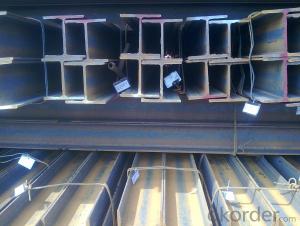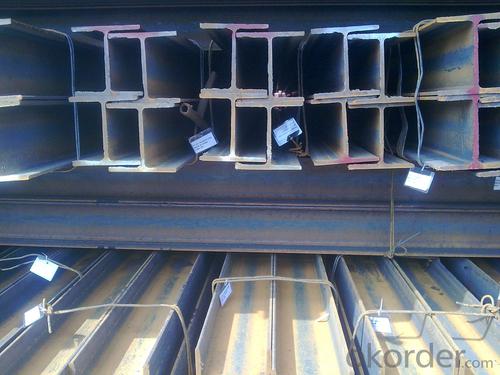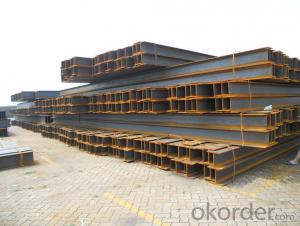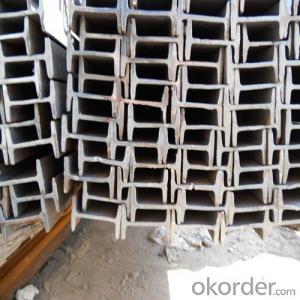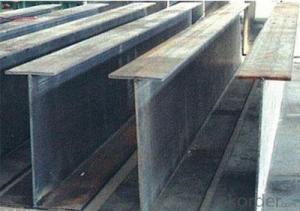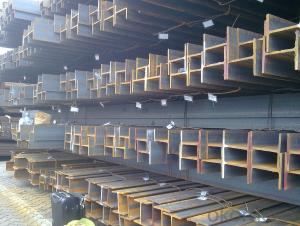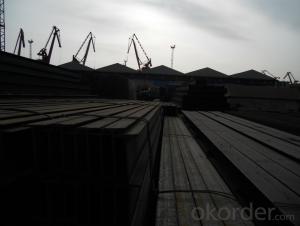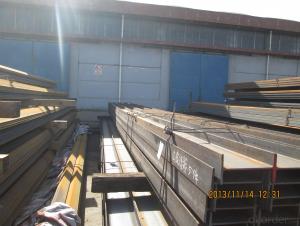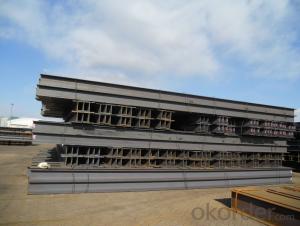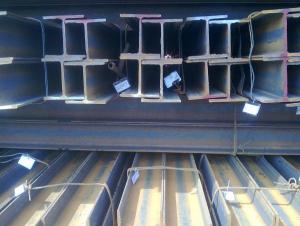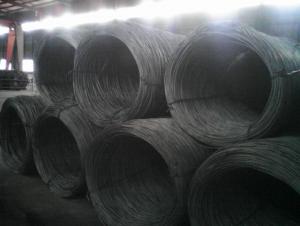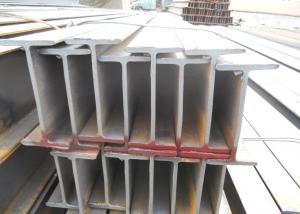H Beam with Good Quality and Multiple Material for Sale
- Loading Port:
- Tianjin
- Payment Terms:
- TT OR LC
- Min Order Qty:
- 25 m.t.
- Supply Capability:
- 20000 m.t./month
OKorder Service Pledge
OKorder Financial Service
You Might Also Like
Specification
Product Description:
OKorder is offering H Beam with Good Quality and Multiple Material for Sale at great prices with worldwide shipping. Our supplier is a world-class manufacturer of steel, with our products utilized the world over. OKorder annually supplies products to European, North American and Asian markets. We provide quotations within 24 hours of receiving an inquiry and guarantee competitive prices.
Product Applications:
H Beam with Good Quality and Multiple Material for Sale are ideal for structural applications and are widely used in the construction of buildings and bridges, and the manufacturing, petrochemical, and transportation industries.
Packaging & Delivery:
Packaging Detail: products are packed in bundle and then shipped by container or bulk vessel, deformed bar is usually naked strapping delivery, when storing, please pay attention to moisture proof. The performance of rust will produce adverse effect.
Each bundle weight: 2-3MT, or as required
Payment term: TT or L/C
Delivery Detail: within 45 days after received advanced payment or LC.
Label: to be specified by customer, generally, each bundle has 1-2 labels
Trade terms: FOB, CFR, CIF
FAQ:
Q1: Why buy Materials & Equipment from OKorder.com?
A1: All products offered byOKorder.com are carefully selected from China's most reliable manufacturing enterprises. Through its ISO certifications, OKorder.com adheres to the highest standards and a commitment to supply chain safety and customer satisfaction.
Q2: How do we guarantee the quality of our products?
A2: We have established an advanced quality management system which conducts strict quality tests at every step, from raw materials to the final product. At the same time, we provide extensive follow-up service assurances as required.
Q3: How soon can we receive the product after purchase?
A3: Within three days of placing an order, we will begin production. The specific shipping date is dependent upon international and government factors, but is typically 7 to 10 workdays.
Images:

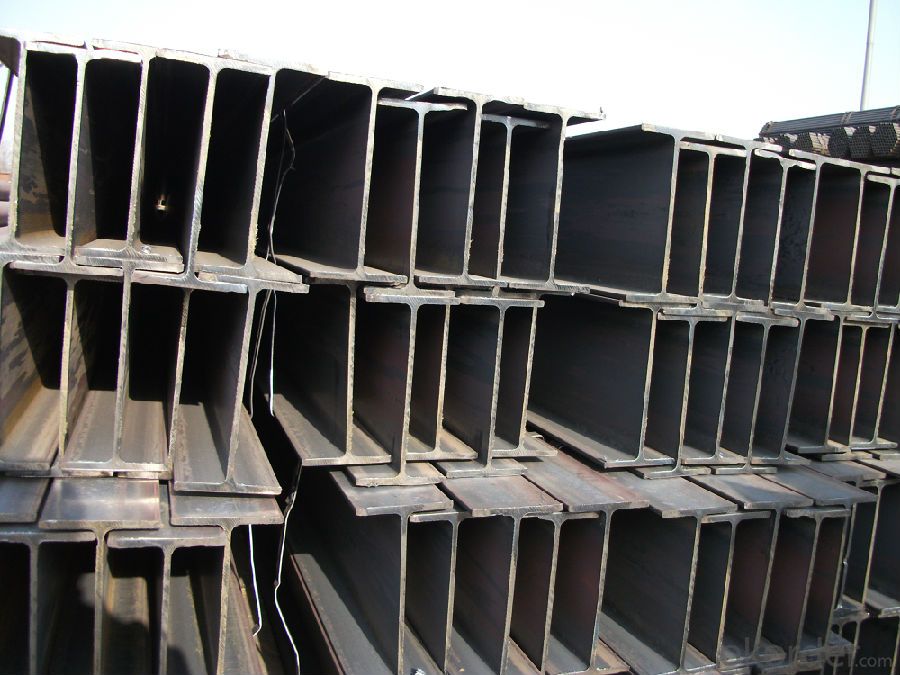
- Q: What are the different grades of steel used in manufacturing H-beams?
- There are several different grades of steel that are commonly used in manufacturing H-beams. These grades are classified based on their mechanical properties and chemical composition. One of the most commonly used grades is ASTM A36, which is a low carbon steel. It has good strength and ductility, making it suitable for a wide range of applications. Another commonly used grade is ASTM A572, which is a high-strength, low alloy steel. It provides excellent strength-to-weight ratio and is often used in heavy construction projects. Other grades that are frequently used include ASTM A992, which is a structural steel with enhanced corrosion resistance, and ASTM A588, which is a high-strength, low alloy steel with improved atmospheric corrosion resistance. The choice of grade depends on the specific requirements of the H-beam, including the desired strength, durability, and resistance to corrosion. Factors such as the load-bearing capacity, environmental conditions, and intended use of the H-beam also influence the selection of the appropriate grade of steel. It is important to consult the relevant industry standards and specifications, as well as the expertise of engineers and manufacturers, to determine the most suitable grade of steel for manufacturing H-beams in a particular application.
- Q: What are the different types of connections used for steel H-beams in bridges?
- There are several different types of connections used for steel H-beams in bridges, including bolted connections, welded connections, and hybrid connections. Bolted connections involve using bolts to connect the H-beams together, providing a strong and easily disassembled connection. Welded connections involve fusing the H-beams together using heat and filler material, creating a permanent and durable connection. Hybrid connections combine elements of both bolted and welded connections, utilizing bolts in certain areas and welding in others to achieve a balance between strength and ease of assembly. The choice of connection type depends on factors such as the design requirements, load capacity, and construction process.
- Q: What are the different types of steel H-beams available?
- There are several different types of steel H-beams available, each with their own unique characteristics and applications. 1. Standard H-beams: These are the most commonly used type of H-beams and have a wide range of applications. They are available in various sizes and dimensions and are used in the construction industry for structural support, such as in the framing of buildings and bridges. 2. Wide flange beams: Also known as W-beams, these H-beams have wider flanges compared to standard H-beams. This design provides increased stability and support, making them suitable for heavy-duty applications, such as in the construction of high-rise buildings, industrial structures, and platforms. 3. I-beams: Although not technically an H-beam, I-beams have a similar shape and are often categorized together. I-beams have a narrower shape compared to H-beams, with a flange on one side and a web on the other. They are commonly used in steel construction projects, including beams, columns, and joists. 4. Tapered H-beams: These H-beams have a tapered shape, with the flanges and web decreasing in thickness from the top to the bottom. Tapered H-beams are used in applications where weight reduction is crucial, such as in the aerospace industry or in certain architectural designs. 5. Light H-beams: These H-beams have a lightweight design and are used primarily in applications where weight is a critical factor, such as in the automotive industry or for lightweight structures. They offer a high strength-to-weight ratio and are available in various sizes. 6. Stainless steel H-beams: These H-beams are made from stainless steel, which offers superior corrosion resistance and durability. They are commonly used in environments where exposure to moisture or chemicals is a concern, such as in coastal areas or in chemical processing plants. It's important to note that the availability of these different types of steel H-beams may vary depending on the supplier or manufacturer. Therefore, it's recommended to consult with a steel supplier or structural engineer to determine the most suitable type of H-beam for your specific application.
- Q: Are steel H-beams suitable for seismic design?
- Indeed, seismic design can certainly make use of steel H-beams as they possess the necessary attributes for such applications. Steel H-beams are widely employed in seismic design owing to their commendable strength and ductility. The unique H-shape of these beams imparts them with a greater capacity to resist bending and torsional forces in comparison to other structural shapes, rendering them exceptionally well-suited to endure seismic loads. Moreover, steel exhibits exceptional qualities for seismic resistance, including a high tensile strength and the capability to absorb and dissipate energy during an earthquake. Additionally, steel H-beams can be tailored to meet specific detailing requirements to further enhance their seismic performance, such as the inclusion of moment connections and appropriate reinforcement. All in all, steel H-beams represent a dependable choice for seismic design due to their strength, ductility, and ability to withstand the forces generated by seismic activity.
- Q: How do steel H-beams contribute to sustainable design?
- Steel H-beams contribute to sustainable design by providing structural strength and durability, allowing for the construction of long-lasting and resilient buildings. Their high load-bearing capacity enables the use of fewer materials, reducing resource consumption and minimizing waste. Moreover, steel H-beams are often made from recycled materials, reducing the demand for new raw materials and lowering carbon emissions. Additionally, their versatility and ease of installation make them suitable for various building types and designs, promoting flexibility and adaptability in sustainable construction practices.
- Q: Do steel H-beams require additional bracing?
- Yes, steel H-beams often require additional bracing. H-beams are structural beams that are used in construction to support heavy loads. While they are designed to be strong and durable, certain factors such as the length of the beam and the load it will bear may necessitate the use of additional bracing. Bracing helps to provide lateral support and prevent the beam from buckling or bending under the weight it is carrying. Depending on the specific requirements and design of the structure, bracing can be added to H-beams through various methods such as diagonal braces, cross braces, or struts. It is important to consult with a structural engineer or a professional in the field to determine the specific bracing needs for steel H-beams in a given construction project.
- Q: Are Steel H-Beams resistant to warping or bowing over time?
- Yes, Steel H-Beams are highly resistant to warping or bowing over time. This is due to their structural design and the inherent properties of steel. H-Beams are manufactured to have a high strength-to-weight ratio, which allows them to withstand heavy loads and maintain their shape over extended periods. Additionally, steel possesses excellent dimensional stability and is less prone to expansion or contraction with changes in temperature or moisture compared to other materials. These characteristics make Steel H-Beams a reliable choice for construction projects where long-term stability is crucial.
- Q: What's the difference between welded H - section steel and high frequency welded H - section steel and hot rolled H section steel?
- The shunt end piece (T profiles, H59 1 brass) two pieces with the resistance sheet (thickness of 1.5, 20 wide, 45 long, 5 pieces of copper manganese); in high frequency heating mode; copper phosphorus solder welding; brazing process requirements: less than or equal to 1min, focused on solving the problem: positioning and welding (before brazing the process of using gas welding method). The main technical and economic indicators: after welding product surface without oxidation, the welding quality is higher than that of gas welding; resistance welding end pieces and reliable, welding without melting and deformation resistance; ensure shunt; the production efficiency is increased by two times.
- Q: How long do steel H-beams last?
- Depending on factors such as the quality of the steel, usage conditions, and maintenance practices, steel H-beams have the ability to last for multiple decades, and in some cases, even longer. The durability and longevity of steel H-beams are well-known due to the inherent strength and resilience of steel as a material. With proper care and maintenance, which includes regular inspections, addressing any signs of corrosion, and protecting them from moisture or extreme weather conditions, steel H-beams can maintain their structural integrity for a significant amount of time. However, it should be noted that the lifespan of steel H-beams can vary depending on the specific purpose and load-bearing requirements. To obtain more accurate and detailed information based on the specific circumstances, it is advisable to consult with a structural engineer or a professional in the construction industry.
- Q: Can steel H-beams be used in residential balcony or terrace structures?
- Residential balcony or terrace structures can indeed utilize steel H-beams. The strength and durability of steel H-beams make them a popular choice for construction projects. They offer exceptional structural support and can handle heavy loads, making them ideal for supporting balconies and terraces. Moreover, steel H-beams can be tailored and designed to fulfill specific architectural and engineering requirements, ensuring a secure and safe structure. Nevertheless, it is imperative to seek guidance from a qualified structural engineer or architect to determine the appropriate size and design of the steel H-beams for the specific residential balcony or terrace structure. This consultation should take into account factors such as load-bearing capacity, local building codes, and environmental conditions.
Send your message to us
H Beam with Good Quality and Multiple Material for Sale
- Loading Port:
- Tianjin
- Payment Terms:
- TT OR LC
- Min Order Qty:
- 25 m.t.
- Supply Capability:
- 20000 m.t./month
OKorder Service Pledge
OKorder Financial Service
Similar products
Hot products
Hot Searches
Related keywords
